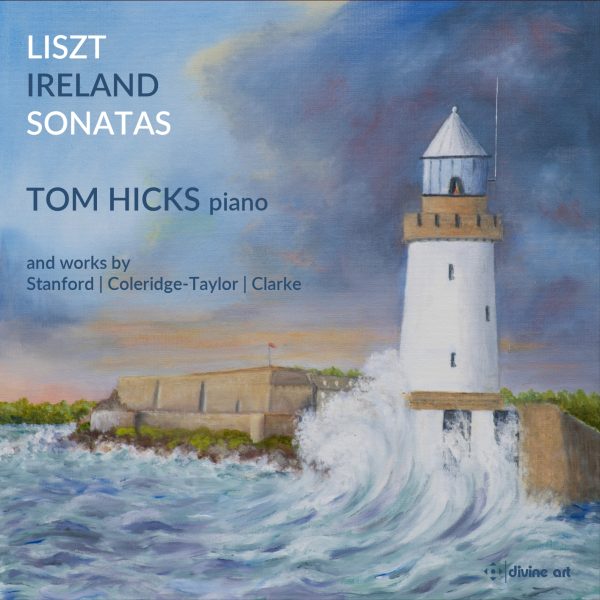American Record Guide
A fascinating collection containing not only John Ireland’s fine sonata, but also the ever-popular Liszt along with some less often encountered pieces. The theme of teacher and pupil presents the celebrated Charles Villiers Stanford along with several of his students. Liszt, of course, was not among them, but that’s OK; and the Guernsey-born young pianist is to be congratulated for his imagination in assembling such an interesting program. I’m also a pushover for the attractive art-work of Castle Cornet, Guernsey by Wendy Heaume.
The Ireland is a most attractive work and is played with close attention to its wonderful variety of rhythms and tonal colors. The Liszt is also played for all its worth, and that is considerable. While the tendency today is to underplay the virtuosic elements of the work, as if to add to the seriousness and profundity, Hicks will have none of that. It’s as if to say “it is what it is” And his stunning technical agility refuses to be suppressed. While tracked in three sections it is played continuously.
It is in the lovely hymn-like ‘non troppo lento’ that Ireland’s sonata reaches its height of expression. This is also the longest movement, and the one that reaches the greatest emotional depth. The third and final movement treads its serious pathway to a conclusion that may remind some of its mentor, or possibly the sonata by Frank Bridge. This performance is not lacking in any aspect, especially when compared with Eric Parkin or Mark Bebbington.
Stanford himself is represented by two of his 24 Preludes. It is enough to give us a flavor of what the master is all about, yet make us regret that more wasn’t included. From his student Samuel Coleridge-Taylor we hear the melodic Waltz 2 from his Op.71, and there’s the searching’ Cortège’ by Rebecca Clarke.
All of this sounds forth in full glory on the Steinway D and is well documented in David Wordsworth’s notes. My only regret is that there was still room for some more.
@divineartrecordingsgroup
A First Inversion Company
Registered Office:
176-178 Pontefract Road, Cudworth, Barnsley S72 8BE
+44 1226 596703
Fort Worth, TX 76110
+1.682.233.4978










![Listen to the full suite of Marcel Dupré’s Variations Sur un Noël, Op. 20 from Alexander Ffinch’s #Expectations release today! listn.fm/expectations [in bio]](https://scontent-dfw5-1.cdninstagram.com/v/t51.71878-15/588904367_2327488161082898_8709236950834211856_n.jpg?stp=dst-jpg_e35_tt6&_nc_cat=105&ccb=7-5&_nc_sid=18de74&efg=eyJlZmdfdGFnIjoiQ0xJUFMuYmVzdF9pbWFnZV91cmxnZW4uQzIifQ%3D%3D&_nc_ohc=AiUKMpkx7d0Q7kNvwGbxfF2&_nc_oc=AdnkH33Zw1rUzEvyUJPz11EZztqwsZdhOZmIewauF2sdF0oPz85saR2YFbQzXcKW4Uw&_nc_zt=23&_nc_ht=scontent-dfw5-1.cdninstagram.com&edm=ANo9K5cEAAAA&_nc_gid=CoEi8mCWCkKbiuKVvDpnyA&oh=00_AfkIkl3nO1pQ6jz5sgXlhE0dT5it3cyD4-ptQOs8BbM80g&oe=6954882A)

![“the ‘Manteca’ Paraphrase – a rare foray into the two-piano medium but here played double-tracked – exudes a panache of which Dizzy Gillespie would surely have approved.… [a] recital well worth investigating.” —Gramophone Magazine with high praise for Ophelia Gordon's debut release, Kapustin: Between the Lines!](https://scontent-dfw5-3.cdninstagram.com/v/t51.82787-15/598796470_18303255136283342_540941604740887837_n.jpg?stp=dst-jpg_e35_tt6&_nc_cat=108&ccb=7-5&_nc_sid=18de74&efg=eyJlZmdfdGFnIjoiRkVFRC5iZXN0X2ltYWdlX3VybGdlbi5DMiJ9&_nc_ohc=IC4zZ7tcpb8Q7kNvwHWkRdI&_nc_oc=Adm3yIfKD2ClTZ-IDzmiD2AxEqFMtf3o3fKDK1o2NIyX-vHAwpPSb6KhcErE4Y9q2O0&_nc_zt=23&_nc_ht=scontent-dfw5-3.cdninstagram.com&edm=ANo9K5cEAAAA&_nc_gid=CoEi8mCWCkKbiuKVvDpnyA&oh=00_AfmV_qy13rDvNWf4f-M5BSUej75HIeQehx_QMa_o5Su17w&oe=69546284)